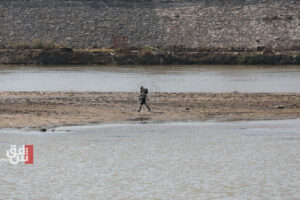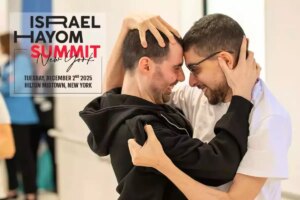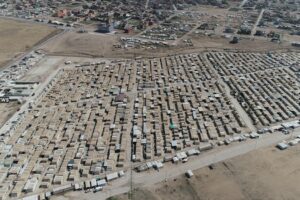
When Yom Kippur War hostages returned home, they were taken to what were called “convalescent homes” in Zikhron Yaakov and Netanya, where security personnel interrogated them for days, relentlessly pursuing the goal of knowing “what they told in captivity and how much they revealed.” Psychiatrists treated them as far from kid gloves as possible, and some still suffer today from the trauma of the return almost as much as from the difficult period in captivity. In 2025, the State of Israel and the IDF did everything to ensure that the return of the captivity survivors would be soft, warm, and embracing, and that they would know that the evil is behind them and that it is possible to begin the rehabilitation process.
“If I take one moment from their return, it’s the moment they entered the compound at Reim Base and understood that the nightmare was over,” said Lt. Col. Daniela Shankar, head of the Personnel Division at the Manpower Directorate, who was there on Monday to greet them. “You see it in their eyes, and it’s so moving. We approached them as a team and said: ‘Welcome, you’re in good hands, everything’s fine, you’ll meet your family soon. Now we’ll help you get organized and reset. Take your time.'”
Lt. Col. Shankar also had a personal stake in the hostages’ return. On October 7, she managed a command center as part of the army, in addition to a personal command center. Her brother Yakir Cohen, a resident of Kibbutz Nir Oz, fought with terrorists in his home and was wounded by gunfire, but he and his family survived, and she was in contact with them until the rescue. “I personally know people who were murdered or kidnapped on that day, dear friends, some of whom I grew up with,” she recounts, her voice trembling. “In this role, I find not only a professional mission, but also personal closure that has not yet ended.”
Nimrod Cohen, an Israeli hostage released from the Gaza Strip holds an Israeli flag after coming off a helicopter at the Ichilov Hospital, in Tel Aviv, Israel, Monday, Oct. 13, 2025 (Photo: AP /Ohad Zwigenberg) APAP /Ohad Zwigenberg
For nearly two years, since the first release pulse, the State and the IDF learned and refined the reception mechanism to soften as much as possible the landing path of the returning captives. “After each pulse, there was a debriefing, and after it, lessons were learned,” Lt. Col. Shankar recounts. “Small things like where we’ll stand in the room, and whether it overloads the returnees too much or stresses them, and up to things that were missing and needed to be completed. We prepared for every scenario.”
The 20 living hostages who returned to Israeli territory this week underwent initial medical examination to check that their condition was stable, and then were directed to private rooms at Reim Base, which underwent conversion from a military room to resemble as much as possible a home with warm colors, soft lighting, and new sheets on the bed.
Next to each room, besides a doctor and mental health officers, seven senior IDF officers waited for the returnees, whose role was to ensure they would lack nothing in their first moments in the country, and most importantly – to make clear to them that they are finally free.
This was a team that already knew each other from the preparation period that preceded the release, because there was concern that this time the reception process would be more complex than its predecessors, both because of the large number of returnees and because of the medical concern, since the videos Hamas published recently showed people who might return in a particularly difficult physical and mental condition.
“There were several meetings of the teams that received the returnees,” Lt. Col. Shiran Herzberg, a member of the reception team, recounts. “We did simulations with actors, and tried to scenario as much as possible the event to arrive prepared, because until now we didn’t really meet such a quantity of returnees, and we didn’t really know what would happen on that day.”
Hat, umbrella, and sunglasses
For several days, the team was on standby near Reim Base, in case there would be a flash release. On Monday, they arrived at the compound at 5:30 a.m. to complete preparations and ensure every room was ready for the returnees, including new sheets, a razor, and a shaving machine. If any of the captivity survivors wanted a festive haircut immediately after returning – a barber was on standby in the adjacent room.
Released Israeli hostage, Guy Gilboa-Dalal at the Rabin Medical Center- Beilinson Hospital, Petah Tikva, Israel October 13, 2025 (Photo: Boaz Oppenheim/GPO/Reuters) via REUTERS
In the shower, they had prepared regular soap, medical soap, and hypoallergenic shampoo, and they went over every detail dozens of times to ensure they didn’t fail. “We underwent a major change from the first returnees’ reception to the last one, and learned what each of them needs,” Major Noy, who was among those greeting them, recounts. “In the first pulse, we bought warm slippers and shower slippers, but we didn’t think there would be those who would want to wear shoes on the release day, so this time, shoes of all types waited for them. Or that in the first returns we brought perfume for women, and then we understood that men also need it. In the last return, the men’s cologne was the highlight, you don’t understand how much they missed the smell. We realized we need to bring them baseball caps, as they might want to keep their condition out of view in the first photos, or provide them with sunglasses since they’re not accustomed to the bright light. From release to release, we refined the needs.”
So that the return would be perfect for every captivity survivor, they equipped the room according to lists prepared in advance, and everything new from the packaging: shoes, pants, shirts, socks, and underwear. Clothes in the size they left home in, and also in a smaller size, because after all, they did lose quite a bit of their weight.
“We try to prepare for everything they might ask for,” Lt. Col. Herzberg says. “Even if it’s a rainy day in the middle of summer, then let there be an umbrella on standby and let there be a knit hat alongside the baseball cap. Everything so nothing will be missing, and the main thing is that they’ll feel comfortable.”
Before the release day, the teams learned from the families about their loved ones’ preferences. What clothes they like to wear, what colors they prefer. Some families didn’t volunteer many details due to the sensitive nature of the days and the nerve-wracking anticipation, prompting the procurement teams to empty shelves in stores. Alongside the clothes laid on the bed, there was also an equipment room stocked with shirts and pants in a variety of sizes and colors, in case they didn’t quite match the desired style.
“There was a request that came specifically from one of the families,” Major Noy recounts. “They asked that the shoes that accompanied their son in certain situations in his life would wait for him in the room. Sometimes the families brought things with them from home and asked that we leave them in the room – whether it’s perfume the child loves, or a shirt they knew he would want to go out to meet them in.”
It turns out that one of the returnees bought a new PlayStation before he was kidnapped, so they brought him one, but sent it straight to the hospital, where he is supposed to stay for several days. At the Reim compound, these were mainly small and personal gestures that waited in the rooms, to make clear to the returnees how much they were thought about at home. For Matan Angrest, a Maccabi Haifa fan, a green scarf of the club waited, while for Rom Braslavski, a Beitar Jerusalem game shirt and a pair of glasses in the appropriate prescription waited.
Released Israeli hostage, Eitan Abraham Mor, at the Rabin Medical Center- Beilinson Hospital, Petah Tikva, Israel October 13, 2025 (Photo: Guy Antonovsky/GPO/Reuters) via REUTERS
The night before her husband’s return, Lishay Miran-Lavi’a asked that a tablet be left in Omri’s room on which he could watch videos of his beloved daughters, Roni and Alma, and fill in the gaps from the two years he lost. For Omri, Elkana Bohbot, and David Cunio, bags with gifts to give to their children when they meet were also waiting. “It was our idea, which we were very concerned about at first,” Major Noy admits. “As a mother, I know that you bring gifts to children when you return from abroad. We’re talking about an enormous dissonance, but they were very moved by the gesture. One of the returnees told me he even thought about it himself.”
Shower after two years
These were spacious rooms in the military base, isolated from the others, especially quiet. After initial medical examinations in a nearby compound, a distance of a few minutes’ walk, the happy families waited.
But the meeting with their loved ones wasn’t really quick. Next to the room prepared for the returnees, doctors and mental health personnel waited, each accompanied by an officer. “We didn’t ask them questions and didn’t conduct conversations. The only one who would ask them was a doctor, and even that, according to a briefing he received,” Lt. Col. Shankar recounts. “If the returnees wanted to tell what they went through – they talked, but the approach was that there’s time for everything. At this stage, what they need is a few minutes to calm down and understand they’re home, with the family waiting for them. We explain what’s right for them, but in the end, the decision is theirs, to give them back control of their lives.”
For the returnees, these were their first minutes in a different reality. From a dark tunnel and difficult conditions, to suddenly moving to a pampering suite where everything is accessible. “On the face of it, it seems disconnected to put perfume in the room for someone who returned from captivity and the most comfortable shoes, but all this is intended to give them a good feeling. They were very happy,” Lt. Col. Shankar recounts. “One asked, ‘is everything here for me?’, another said, ‘can we take it with us?’ They hadn’t seen these things for so long, and felt good to return to showering. Many of them felt they needed to remove the clothes that were with them in Gaza, and one said before the medical examination, ‘I must wash myself before, I feel uncomfortable, I stink’. He had a feeling he must return to himself.”
The officers in the compound were already nicknamed “the dream fulfillers.” Everything the hostages asked for was given to them, even if it didn’t wait in the room. First cigarette after returning to the country, tasty food with doctor’s approval, and if they wanted a snack that wasn’t on the base – a driver team was rushed to a nearby supermarket or convenience store, to bring them as quickly as possible.
Released Israeli hostage Evyatar David reacts upon arriving at Beilinson Hospital in the Rabin Medical Centre in Petah Tikva in central Israel on October 13, 2025 (Photo: Gol Cohen-Magen / AFP) AFP
In those minutes, the families waited, and each of them was given a private room with drinks, food, and a shower to freshen up. Despite the strong desire to meet their loved ones soon, they were advised that it was preferable to give the returnees time to get organized and calm down from everything they had gone through.
“All the returnees I met felt the importance of the shower and getting organized before the meeting,” Major Noy recounts. “We also explained to them that this is the most suitable time, because after this they’re about to enter a sequence of meetings and arrival at the hospital and a whole circus, and it’s possible they won’t manage to make the small stop for themselves. It was still subject to their choice. I didn’t meet anyone who chose otherwise.”
Some of the captivity survivors entered the room alone to get organized, and some needed help. Some stayed a long time under the stream of hot water, and after two dark years, enjoyed a real shower that washed away the filth.
“After he finished getting organized, one of the returnees consulted with me about which shirt to put on when he meets his family,” Major Noy laughs. “He said, ‘what do you say, will this shirt match these pants? You have a woman’s eye, what do you really think?’ I told him, ‘wait a moment, I’ll bring you all the shirts in all colors and we’ll choose together, I’m with you.'”
“Mission of my life”
The three officers recount that if there’s a moment on that day when they had difficulty maintaining composure, it was the moment when the families reunited after two long years of longing. Then, according to the drill, they stood quietly, took a side corner, and allowed the emotions to burst forth.
“It’s crazy, it really catches you in the throat,” Major Noy recounts. “The last return was closure for us, but I especially remember the return of the children. I was after my third birth, and I stopped the leave to return to service and see children returning from Gaza. When you have children at home, these are things impossible to absorb.”
Can you cry when you’re in the role?
“It was important to us to give them privacy in the meeting with the family; we respected their precious time. But you hear things that automatically shake you, and you cry. There’s no other way to say it.”
“Next to them, I didn’t really break down. I turned around and shed a tear or two, but mainly, you need to be restrained and keep cool. More than once, I told my family that if I were sitting like them in front of the television – I would certainly be with a river of tears.”
Lt. Col. Herzberg recounts that it was difficult for her to restrain herself in these moving moments. “You don’t have to maintain composure on such days,” she says. “It’s a very disintegrating situation, and I shed quite a few tears, but it doesn’t matter, because we still gave them all the possible intimacy. It’s completely their moment, and in the end, we’re also human beings. Just as you cry when you see these videos at home – so imagine what it is to be there.”
Herzberg just this week received the rank of lieutenant colonel and was appointed head of the wounded escort division. A veteran officer who knows there aren’t many moments in service that compare to what she went through this week in the south.
“In the last two years, we’ve been in intensive fighting. As a mother who took part in the war and felt October 7 intensely from friends and commanders – to be part of their return, which in my eyes was a commitment, is an enormous privilege,” she says. “I’m grateful for the fact that I was there in those moments.”
Released Israeli hostage Avinatan Or greets well-wishers upon arriving at Beilinson Hospital in the Rabin Medical Centre in Petah Tikva in central Israel on October 13, 2025 (Photo: Menahem Kahana / AFP) AFP
The process of receiving the returnees was relatively short. Medical examination, hot shower, meeting with the family, and then take off in a helicopter to the hospitals. The teams at Reim Base didn’t forget to send the captivity survivors with bags loaded with equipment purchased especially for them.
We’re talking about a short period, of an hour or two, but for those who were in the compound in those moments, these were no less than historical minutes, minutes in which a nation began a long process of rehabilitation and recovery after two difficult and bloody years.
“This was without doubt the mission of my life,” Lt. Col. Shankar is convinced. “This is the most valuable and noble mission I’ve encountered in my military service, and it’s a great privilege to take part in it. But from our perspective, as an army and as a state, the mission won’t be completed until all the hostages return home, and I pray this will happen soon.”
The post How hospitals prepare rooms for hostages appeared first on www.israelhayom.com.





